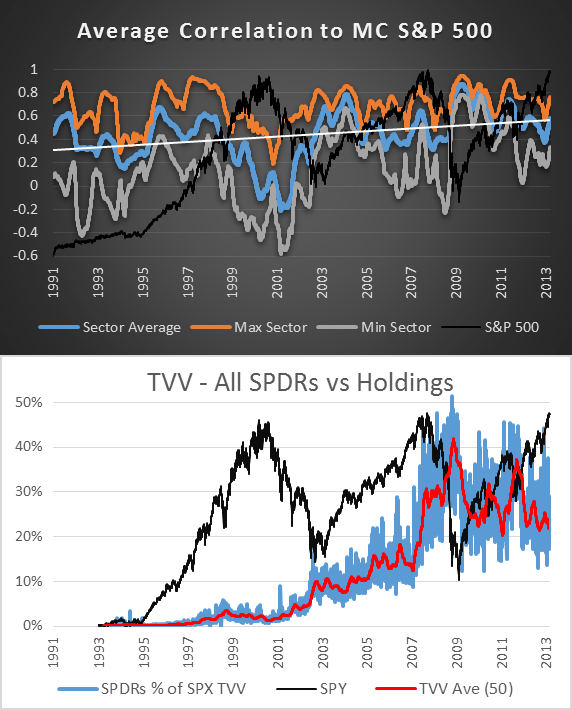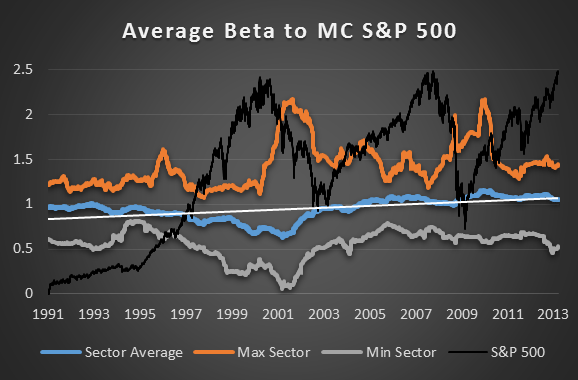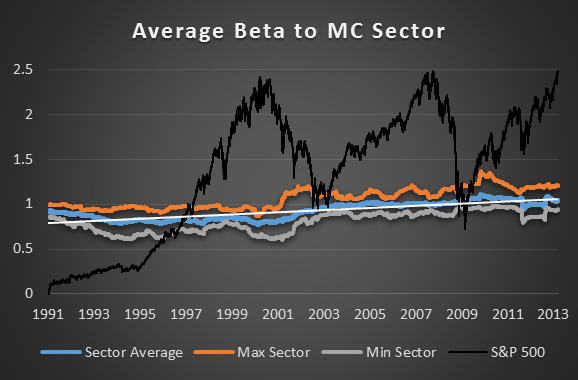It has been said that stocks held by the major ETFs have become more correlated over time as the popularity and volume of these ETFs has increased. As you know each ETF physically holds a basket of stocks in the weighting if the index or asset group that they are designed to emulate. If enough trading of the ETF occurs then in theory the tail could wag the dog and move the underlying assets that are supposed to be being tracked.
Volume, (with regard to financial securities) refers to the number of trades that have taken place. This is a useful useful measure but it isn’t relative. If two stocks both have a daily volume of 100,000 but one is trading at $4 and the other at $400, then a volume comparison does not make sense. A more useful measure is Trading Volume Value (TVV) which is simply the price times the volume.
SPY is now the worlds most heavily traded ETF but on day 1, January 29th, 1993 its TVV was just $44.1 million; a tiny fraction of the 7.3 trillion for all of the S&P 500 stocks combined. Fast forward to November 20th, 2008 and the TVV for SPY and the other SPDR sector ETFs was over 50% of the TVV for the entire S&P 500. We are talking about $70 trillion dollars flowing through the SPDRs in one day!! If the tail is 52% of the dog then who is waging who? Here is a chart:

To measure the change in correlation for the constituents of the S&P 500 over time, I first took the average 252 day (one trading year) correlation relative to the S&P 500 for each individual stock split by sector (creating 9 sector averages). Then on the chart ‘Average Correlation To MC S&P 500′ I plotted the average of each sector along with the reading for the sector with the highest and the lowest average correlation. Below that on the chart ‘TVV – All SPDRs vs Holdings’ you can see the sum of the TVV for SPY and the 9 sector ETFs as a percentage of the TVV for all the S&P 500 stocks.
When the market was falling violently during the first few months of 2009 the average correlation was over 80% and there was very little difference between the most and least correlated sector. In other words; everything was going down creating a ‘nowhere to hide’ scenario (this pattern is was slightly more pronounced within the sectors themselves).
At the time TVV was at record levels, averaging around 25% but a similar ‘nowhere to hide’ situation was also seen during the bull markets of 2003 and 2004 while TVV at that time was only around 10%. So we have examples of very high correlation during bull and bear markets, through varying levels of ETF TVV. So volume on these ETFs certainly has an impact but it is not the only factor. (see TVV for each sector individually)
What about beta? Are the S&P 500 stocks becoming more or less volatile in relation to the SPX?

Clearly there has been an upward drift in beta from the S&P 500 constituents over the last 20 years but at all times there has remained a healthy spread between high and low beta sectors. Within each sector however that spread is much smaller:

Conclusion
Trading Volume Value (TVV) has increased dramatically on the SPDRs since SPY was first introduced back in 1993. This increase can be seen having an impact on the correlation of the S&P 500 constituents but is clearly not the only factor that causes correlation to fluctuate. I would speculate that automated trading algorithms and qualitative easing by the Fed are also major factors (among others).
During some periods correlation will be to such level that it will be almost impossible for stock pickers or sector selectors to escape the trend of the broad market. At such times a specific directional bias will be mandatory as a delta neutral strategy would be an exercise in futility.
Over the last 10 years the average correlation to the S&P 500 has been 56% and for each stock to its sector, 63%. For this reason you would be unwise to ignore the trend of the broad market and utterly foolish to trade a stock against the trend of its sector. Yes, the trend is your friend and that friendship is developing.
Stock beta has also shown to be drifting higher over time and while the beta spread does fluctuate it has remained fairly wide for the last 20 years. This means that at any time risk can be adjusted by taking positions in sectors with higher or lower betas. Take note however; the beta spread within a sector is much more slight and consistent.
More in this series:
This is part of a research series on the S&P 500 and its Sectors utilizing historical constituent data. Here is proof that our database is accurate.